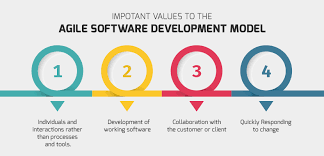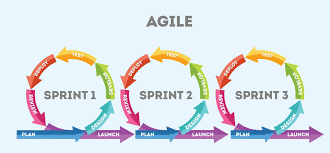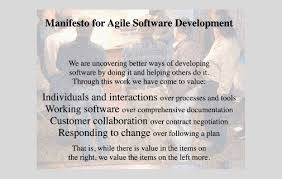Unveiling the Power of the Manifesto for Agile Software Development
The Manifesto for Agile Software Development
Agile software development has revolutionized the way software is created and delivered. At the heart of this movement is the Manifesto for Agile Software Development, a document that outlines the core values and principles that guide agile methodologies.
Core Values of the Agile Manifesto
The Agile Manifesto is based on four core values:
- Individuals and interactions over processes and tools: Emphasizing the importance of collaboration and communication within teams.
- Working software over comprehensive documentation: Prioritizing functional software over extensive documentation.
- Customer collaboration over contract negotiation: Focusing on working closely with customers to meet their needs.
- Responding to change over following a plan: Being adaptable and responsive to changes in requirements throughout the development process.
Principles of the Agile Manifesto
In addition to these core values, the Agile Manifesto also includes twelve principles that further define agile methodologies. Some of these principles include:
- Satisfy the customer through early and continuous delivery of valuable software.
- Welcome changing requirements, even late in development.
- Deliver working software frequently, with a preference for shorter timescales.
- Build projects around motivated individuals. Give them the environment and support they need, and trust them to get the job done.
The Impact of Agile Software Development
The adoption of agile methodologies has led to increased productivity, faster time-to-market, improved quality, and greater customer satisfaction in software development projects. By embracing the values and principles outlined in the Agile Manifesto, teams can work more collaboratively, adapt to changes more effectively, and deliver value to customers more efficiently.
In conclusion, the Manifesto for Agile Software Development serves as a guiding light for teams looking to embrace agile practices in their software development processes. By prioritizing individuals, collaboration, working software, customer needs, and adaptability, organizations can achieve success in today’s fast-paced and dynamic digital landscape.
Understanding the Agile Manifesto: Answers to Frequently Asked Questions
- What is the Manifesto for Agile Software Development?
- What are the core values of the Agile Manifesto?
- What are the principles of the Agile Manifesto?
- How has agile software development revolutionized the industry?
- Why is collaboration emphasized in agile methodologies?
- How does agile development prioritize customer needs?
- What role does adaptability play in agile software development?
- How can teams benefit from embracing the Agile Manifesto?
What is the Manifesto for Agile Software Development?
The Manifesto for Agile Software Development is a foundational document that encapsulates the core values and principles guiding agile methodologies in software development. It emphasizes prioritizing individuals and interactions over processes and tools, working software over comprehensive documentation, customer collaboration over contract negotiation, and responding to change over following a rigid plan. This manifesto serves as a compass for teams looking to embrace agility in their development processes, promoting adaptability, customer focus, collaboration, and iterative delivery of value throughout the software development lifecycle.
What are the core values of the Agile Manifesto?
The core values of the Agile Manifesto encapsulate the fundamental principles that underpin agile software development practices. These values emphasize the importance of prioritizing individuals and interactions over processes and tools, working software over comprehensive documentation, customer collaboration over contract negotiation, and responding to change over following a rigid plan. By embracing these core values, teams can foster a culture of collaboration, adaptability, customer-centricity, and continuous improvement in their software development endeavors.
What are the principles of the Agile Manifesto?
The principles of the Agile Manifesto encompass key guidelines that shape agile software development methodologies. These principles emphasize customer satisfaction through early and continuous delivery of valuable software, welcoming changing requirements even late in development, delivering working software frequently with shorter timescales, and building projects around motivated individuals while providing them with the necessary support and trust to excel in their roles. By adhering to these principles, teams can foster collaboration, adaptability, and a focus on delivering high-quality solutions that meet customer needs effectively in today’s dynamic software development environment.
How has agile software development revolutionized the industry?
Agile software development has revolutionized the industry by introducing a more flexible and adaptive approach to software development projects. Unlike traditional methods that follow rigid processes and extensive documentation, agile methodologies prioritize collaboration, working software, customer feedback, and adaptability to change. This shift in mindset has led to increased productivity, faster delivery of value to customers, improved quality of software products, and higher levels of customer satisfaction. By embracing the core values and principles outlined in the Manifesto for Agile Software Development, organizations can respond more effectively to evolving market demands, innovate at a quicker pace, and ultimately stay competitive in today’s dynamic business environment.
Why is collaboration emphasized in agile methodologies?
Collaboration is emphasized in agile methodologies because it lies at the core of effective and successful software development practices. By promoting collaboration among team members, stakeholders, and customers, agile methodologies ensure that everyone is aligned towards a common goal. Through open communication, sharing of ideas, and collective problem-solving, teams can work more efficiently and deliver higher-quality software. Collaboration fosters a sense of ownership and accountability among team members, leading to increased motivation and productivity. Ultimately, by prioritizing collaboration, agile methodologies enable teams to adapt to changing requirements, deliver value to customers more effectively, and achieve success in today’s dynamic and fast-paced software development landscape.
How does agile development prioritize customer needs?
Agile development prioritizes customer needs by fostering a collaborative and iterative approach to software development. In agile methodologies, customer involvement is crucial throughout the development process. By engaging customers in regular feedback sessions and demonstrations of working software, agile teams ensure that the product aligns with the customer’s requirements and expectations. Agile practices such as user stories, continuous delivery, and frequent testing allow for quick adjustments based on customer feedback, enabling teams to deliver value early and often. This customer-centric focus in agile development ultimately leads to greater customer satisfaction and the delivery of products that truly meet the needs of the end-users.
What role does adaptability play in agile software development?
Adaptability plays a crucial role in agile software development by enabling teams to respond effectively to changes in requirements and priorities throughout the development process. In the context of the Agile Manifesto, adaptability aligns with the principle of “Responding to change over following a plan,” emphasizing the importance of flexibility and responsiveness. By embracing adaptability, agile teams can adjust their approach, incorporate feedback, and deliver value incrementally, ultimately leading to more successful outcomes and satisfied customers. The ability to adapt quickly and efficiently is a key factor in the success of agile software development projects, allowing teams to stay nimble and deliver high-quality products that meet evolving needs.
How can teams benefit from embracing the Agile Manifesto?
Embracing the Agile Manifesto can bring numerous benefits to teams in the software development industry. By prioritizing individuals and interactions, teams can foster a culture of collaboration and communication, leading to improved teamwork and efficiency. Working software over comprehensive documentation allows teams to focus on delivering functional products quickly, resulting in faster time-to-market and increased customer satisfaction. Additionally, embracing customer collaboration enables teams to better understand and meet client needs, ultimately enhancing product quality and success rates. Furthermore, by responding to change over following a rigid plan, teams become more adaptable and responsive to evolving project requirements, leading to greater flexibility and innovation in their development processes. Overall, embracing the Agile Manifesto empowers teams to work more effectively, deliver value efficiently, and achieve success in today’s competitive software development landscape.





